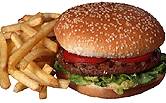
MONDAY, Nov. 5 (HealthDay News) — Whether at fast food places or full-service restaurants, kids who eat out are likely to consume more calories, sugar, fat and salt, researchers from the University of Illinois at Chicago report.
They also noted that kids are eating out more, particularly in fast-food restaurants, which has helped drive the obesity epidemic among children and teens.
“Every day, about 40 percent of U.S. children eat at these restaurants,” said lead researcher Lisa Powell, director of the university’s Health Policy Center of the Institute for Health Research and Policy.
“We need policies that promote healthier food choices, rather than one that promotes unhealthy food choices,” she added.
“We also need to change the environment in the restaurant so that there won’t be harmful effects on diet,” Powell said. This would include not offering free refills on soda and increasing healthier food choices, she explained.
The report was published in the Nov. 5 online edition of the Archives of Pediatrics & Adolescent Medicine.
For the study, Powell and her colleague, Binh Nguyen, collected data on restaurant eating among more than 4,000 children between the ages of 2 and 11 and almost 4,700 teens between the ages of 12 and 19, who took part in the 2003-2008 National Health and Nutrition Examination Survey.
In particular, they looked at the total energy intake — called kilocalories, which is similar to total calories — of sugar-sweetened drinks like sodas.
When children eat in fast-food restaurants, their daily energy intake goes up 126 kilocalories, and for teens, it increases by 309 kilocalories, Powell and Nguyen found.
In full-service restaurants, daily energy intake increased 160 kilocalories for kids and 267 kilocalories for teens, they added.
In addition, eating out meant getting 13 percent more sugar, 22 percent more total fat, 25 percent more saturated fat and 17 percent more salt than what is recommended, Powell and Nguyen said.
A lot of those extra calories came from sodas, which kids and teens drink when they eat out, the researchers said.
This problem is particularly acute among poorer families. Eating at fast-food restaurants is a way to get a lot of food inexpensively, Powell noted.
“Even with the general outcry that portions are too big, too high in sodium, fat and sugar, restaurants and fast food chains continue to increase the portion sizes of their foods,” said Samantha Heller, an exercise physiologist and clinical nutrition coordinator at the Center for Cancer Care at Griffin Hospital in Derby, Conn.
For example, she said, Wendy’s recently introduced the “Triple Baconator,” which has about 1,300 calories and Subway introduced “Footlong” recession specials that have almost 1,200 calories each, she said.
“In addition, food companies incentivize buying the jumbo-sized products compared with the smaller portion,” Heller added, noting that a recent study in the Archives of Internal Medicine, reported that “competition has encouraged the food industry to offer larger-size portions as a way to expand market share.”
“It’s no wonder kids are gaining weight and suffering from adult diseases such as high blood pressure and type 2 diabetes. We need to encourage people to cook at home more often and dispel the myth that eating at home is more expensive than eating out,” she added.
“Planning menus ahead, making shopping lists and carving out time for home-cooked meals will make eating at home easier, more enjoyable and healthier for the whole family,” Heller said.
More information
For more information on healthful eating, visit the U.S. Department of Agriculture.

